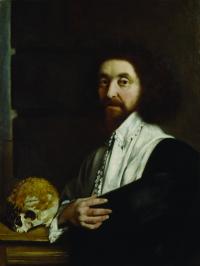Skulls for sale: English conquest and cannibal medicines
Published in 18th–19th - Century History, Early Modern History (1500–1700), Features, Issue 3 (May/June 2011), Volume 19
Portrait of English botanist and gardener John Tradescant the Younger (1608–62)—note the moss-covered skull. According to a 1738 medical work, ‘the skull of a man ought to be of such an one as dieth a violent death (as war, or criminal execution) and never buried: therefore those of Ireland are here best esteemed, being very clean and white, and often covered over with moss’. (National Portrait Gallery, London)
Picture this: you are approaching the rudimentary home of a soldier one evening as the dusk falls. Squinting through the uncertain light, you wonder for a moment why a man such as this should have contrived a kind of rockery alongside the path that leads to his tent. In fact, the objects neatly spaced on either side of the approach are not rocks but human heads—freshly severed that day, and staring up at those who dare approach the tent of this legendary figure. For anyone who has read Joseph Conrad’s Heart of Darkness, this scene brings to mind the African home of Kurtz, with its surrounding heads thrust on poles. But the rockery of severed heads in fact derives from a much earlier phase of English imperialism: the tent is that of Humphrey Gilbert, who in 1566 was called to Ireland to help fight the Irish chieftain Shane O’Neill. O’Neill was indeed defeated—by betrayal—the following year, and his was the most famous scalp of that year, his head being preserved in salt so that it could be displayed on a pike at Dublin Castle. More anonymously, numerous men, women and children were slaughtered during Gilbert’s campaigns, in attacks so ruthlessly thorough that—even if heads were not chosen to ornament the English camp—there was often no one left to bury the dead.
‘The moss of an unburied cranium; the fat of man . . .’
Although the various oppressions of Ireland by early modern English forces are relatively well
known, my interest here is in a forgotten strand of Anglo-Irish relations. What links the unburied corpses of Ireland with Francis Bacon, Robert Boyle, the clergyman Richard Baxter, Charles II, the
import–export duties of the eighteenth century, and the chemists’ shops of London and Germany?

Sir Humphry Gilbert, who first came to Ireland in 1566, ordered the decapitation of entire villages in order to have the path to his tent decorated with ‘a lane of heddes’ prior to inviting the submission of local chiefs and leaders. (NTPL)
The answer is medicine. For around 200 years the human skull was a popular medical ingredient: grated or powdered, and often distilled, it was used against epilepsy, convulsions and various diseases of the head. In Germany in particular skulls were also integral to the ‘wound salve’: an ointment employed to treat wounds, by application not to the patient but to the weapon or implement that had injured them. A fairly typical recipe for this salve involved ‘the moss of an unburied cranium; the fat of man, each two ounces; mummy, human bloodeach half an ounce’, and ‘oil of linseed, and turpentine, each one ounce’.
Why Irish skulls? One obvious reason was that the English felt less scruples about mutilating and cannibalising their subject neighbours than they did about their own countrymen. But there were also precise medical reasons. First, it seems that moss is more likely to grow on human skulls that are unburied; second, many skull recipes specified the skull of a man who had died a violent death. Thus Francis Bacon (d. 1626) noted helpfully that one could obtain skull-moss from the ‘heaps of slain bodies’ lying unburied over in Ireland.
Although Bacon himself had evidently not been to Ireland, his friend Essex certainly had. (As England’s ‘most famous soldier’, he was among those helping to pile up these ‘heaps of slain bodies’ in his campaign of 1599.) We also know that a very eminent scientist later took up Bacon’s hint. One summer the ‘father of chemistry’, Robert Boyle, was very badly afflicted by nosebleeds. During an especially violent instance, Boyle decided to use ‘some true moss of a dead man’s skull, which had been sent’ to his sister ‘by a great person, for a present out of Ireland’. The usual method was to insert the moss—often powdered—directly into one’s nostrils. But in this case Boyle found that he was able to completely halt the bleeding merely by holding the moss in his hand. In good scientific fashion he later repeated this experiment several times, thus confirming that the moss could work at a distance. Whilst Boyle’s father, Richard, was the richest man in Ireland, Boyle also implies that skull-moss was generally associated with the Emerald Isle—a country in which it was ‘less rare and more esteemed than elsewhere’.
![William Chiffinch, Charles II’s private secretary, used ‘his master’s salutiferous [king’s] drops’ to spike drinks, and ‘thus fished out many secrets, which the king could never have obtained . . . by other means’.](/wp-content/uploads/2013/03/88_small_1303995637.jpg)
William Chiffinch, Charles II’s private secretary, used ‘his master’s salutiferous [king’s] drops’ to spike drinks, and ‘thus fished out many secrets, which the king could never have obtained . . . by other means’.
The clergyman Richard Baxter—who was both immensely pious and immensely sickly—found similar relief from nosebleeds by the use of skull-moss (though Baxter probably inserted the moss, powdered, directly into his nostrils). But the most famous user of human skull was rather less conventionally pious—and certainly less austere. Charles II more or less patented this form of corpse medicine during the Restoration. Originally, the recipe for distilled powder of the skull was closely associated with the physician Jonathan Goddard. But once Charles bought the recipe from him (possibly for as much as £6,000) ‘Goddard’s drops’ were increasingly known as ‘the king’s drops’.
Charles probably distilled the drops himself in his own private laboratory, and he evidently regarded them as a medicine of first and last resort. They were the first thing he took on 2 February 1685, after he awoke ‘feeling ghastly’. A few days later he would be dead—but not before his desperate physicians had plied their dying monarch with especially high doses of the king’s drops. Their failure seems not to have damaged their reputation. Between 1686 and 1698 we find them used by the gentlewoman Anne Dormer (for depression), sent by William Cartwright, bishop of Chester, to a dying friend, requested by the Prince de Conti for his epileptic son in Paris, and used once again on the deathbed of Queen Mary, two years before the turn of the century.Did the king’s drops actually work? It seems that they were certainly potent. Charles’s private secretary, William Chiffinch (c. 1602–91), was wont to spy for the king by putting ‘his master’s salutiferous drops . . . into the glasses’ of his

Robert Boyle, ‘father of chemistry’—to treat nosebleeds he used ‘some true moss of a dead man’s skull, which had been sent . . . out of Ireland’, where it was ‘less rare and more esteemed than elsewhere’.
fellow drinkers, and ‘thus fished out many secrets, which the king could never have obtained . . . by other means’. The lawyer and politician Roger North (1651–1734) claimed that one of his worst drinking experiences occurred at Windsor, when Chiffinch, who ‘delighted to send his guests away foxed . . . put the king’s drops (an extract of bone) in our wine. I had not very much, but found it heavy, and that I must have some care to carry it off steadily’. After this North’s memory grows hazy: he went groggily ‘over the tarras into the park, and then to the side of the cliff among the bushes’, where ‘I laid me down and lay on the ground for six hours. If any saw me or not I know not. My brother jested and said he wished the king had walked that way, and found his learned counsel drunk in a bush.’
Moss-covered skulls
By the mid-eighteenth century educated opinion had finally begun to turn against corpse medicines. Yet when Dr Johnson and others lamented the use of such ‘horrid medicines’ they had to admit that both mummy and human skulls remained on sale in chemists’ shops. In 1694 Pierre Pomet—chief apothecary to Louis XIV—had commented on how ‘English druggists, especially those of London, sell the heads or skulls of the dead, upon which there is a little greenish moss’, like that on oaks. Pomet’s colleague, Moise Charas, had seen these on a visit to England, and had also noticed how some heads were ‘entirely covered with moss, and some . . . only have the moss growing on some parts’. We cannot be sure that the skulls were so prominently displayed in Johnson’s time. But Pomet and Charas tell us at least two things. First, England in particular was associated with the sale of moss-covered skulls. Second, a serious consumer would buy a moss-clad skull so that they could be assured of getting the genuine article. They could use both skull and moss, safe in the knowledge that the latter had not been merely torn off a log or a country wall.
Both these details suggest that England was indeed obtaining such skulls from Ireland. Pomet also described the English export of moss-covered skulls ‘to foreign countries, especially Germany’, where they were used in wound salve, as well as to stop bleeding. And, Pomet adds, ‘the English druggists generally bring these heads from Ireland; that country having been remarkable for them ever since the Irish massacre’. Again, in a medical work of 1738 we hear that ‘the skull of a man ought to be of such an one as dieth a violent death (as war, or criminal execution) and never buried: therefore those of Ireland are here best esteemed, being very clean and white, and often covered over with moss’.
We know that moss-clad skulls had quite a high value. Back in Charles II’s time, a bare skull alone could be worth eleven shillings. And we also know that by the reign of George I human skulls had become an international commodity. Buried away in a 1725 list of customs duties is the brief but telling line: ‘cranium humanum—one shilling’. As late as 1778 this commodity was still liable for duty, and was also listed amongst goods that were imported into England before being exported elsewhere. The conclusion seems certain: skulls were shipped from Ireland and then sold on into Germany, where demand for corpse medicines was especially strong and enduring. Long before the British Empire shipped living slaves to the West Indies, the Irish victims of English occupation became mercantile commodities after their deaths.
There is some reason to think that both the wound salve and skull-moss actually worked. In the first case, the patient had the good luck not to be touched by a surgeon—who at this time would rarely have thought of washing his hands, and would certainly never have sterilised his instruments. Accordingly, the therapy meant that you were less likely to die of blood-poisoning. And the moss? Early modern physicians thrust a good many things (chalk, mint, pig’s dung) up the nostrils of those with bleeding noses. If they worked, it was probably because the sufferer held their head back, and had the flow of oxygen through the nostrils cut off by whichever substance was used. We also know that the mildly antiseptic sphagnum moss was used against haemorrhaging in both the First and Second World Wars, and that folk medicine has often treated bleeding by sprinkling powder on the wound. There is some evidence that many types of powder can help to coagulate blood (and it may have been for this reason that, as late as 1719, powdered skull-moss formed a kind of rudimentary tampon for those suffering from excessive menstrual flux).
For many readers, the wholesale cannibalisation of Irish dead may well seem an appropriate irony. In some contexts, imperial oppressors themselves have been described as ‘cannibals’—a label that indicates not literal consumption of human bodies but the kind of violent transgression of ordinary limits associated with tribal forms of man-eating. Yet there is one more, perhaps stranger, irony lurking within the folds of this now forgotten history. As Pomet himself stated, such heads were especially common in Ireland after the ‘Irish massacre’. For once, this was not a massacre of the Irish but by them—the rising of October 1641, which claimed the lives of thousands of Protestant settlers. From the time of Cromwell, then, it may have been very difficult to know whether you were distilling or swallowing the skull of an Irishman or of an English or Scottish settler. Whatever the case, the reader is entreated to bear in mind a traditional caveat: please do not try any of these medicines at home. HI
Richard Sugg lectures in Renaissance literature at the University of Durham.
Further reading:
D. Edwards, ‘Some days two heads, some days four’, History Ireland 17 (1) (2009).
P. Palmer, ‘“A headlesse ladie” and “a horses loade of heades”: writing the beheading’, RQ 60 (1) (2007), 25–57.
R. Sugg, ‘Early modern cannibal doctors’, BBC History (March 2007), www.historyextra.com.
R. Sugg, Mummies, cannibals and vampires: the history of corpse medicine from the Renaissance to the Victorians (Oxford, 2011).
















